CHEVROLET CAMARO SS 2010 Owners Manual
Manufacturer: CHEVROLET, Model Year: 2010, Model line: CAMARO SS, Model: CHEVROLET CAMARO SS 2010Pages: 372, PDF Size: 1.91 MB
Page 311 of 372
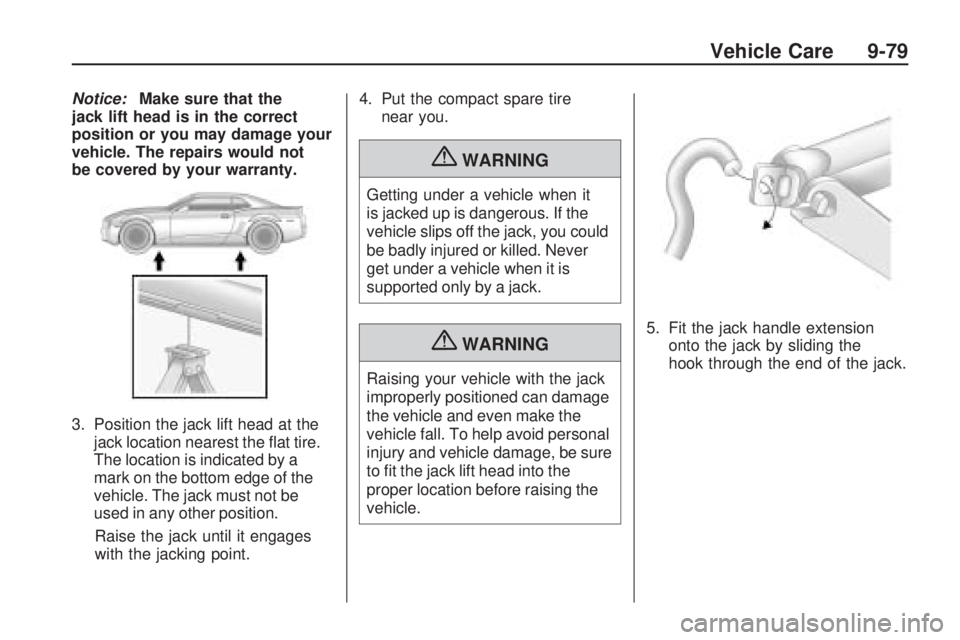
Notice:Make sure that the
jack lift head is in the correct
position or you may damage your
vehicle. The repairs would not
be covered by your warranty.
3. Position the jack lift head at the
jack location nearest the flat tire.
The location is indicated by a
mark on the bottom edge of the
vehicle. The jack must not be
used in any other position.
Raise the jack until it engages
with the jacking point.4. Put the compact spare tire
near you.
{WARNING
Getting under a vehicle when it
is jacked up is dangerous. If the
vehicle slips off the jack, you could
be badly injured or killed. Never
get under a vehicle when it is
supported only by a jack.
{WARNING
Raising your vehicle with the jack
improperly positioned can damage
the vehicle and even make the
vehicle fall. To help avoid personal
injury and vehicle damage, be sure
to fit the jack lift head into the
proper location before raising the
vehicle.5. Fit the jack handle extension
onto the jack by sliding the
hook through the end of the jack.
Vehicle Care 9-79
Page 312 of 372
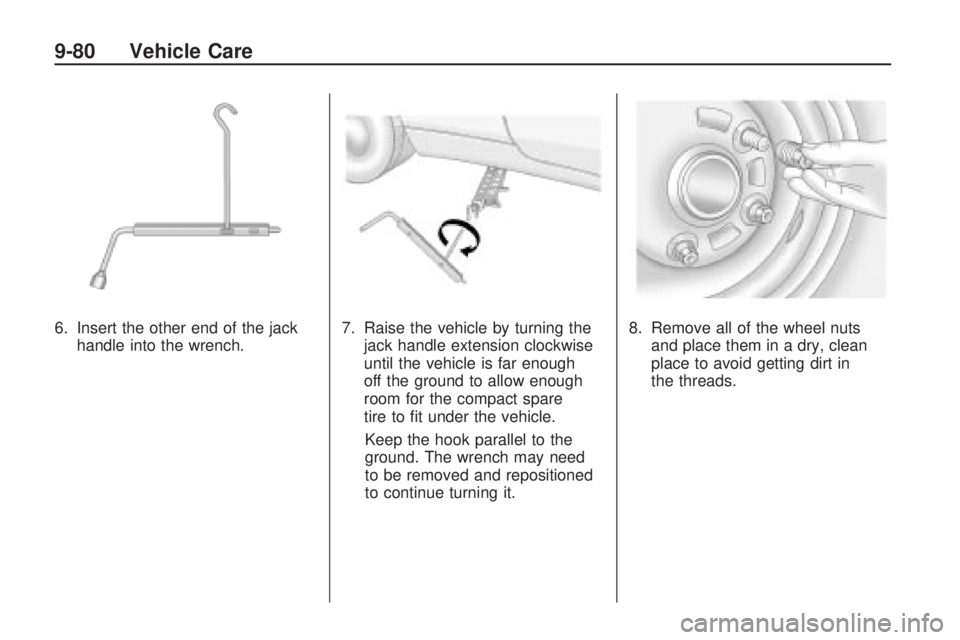
6. Insert the other end of the jack
handle into the wrench.7. Raise the vehicle by turning the
jack handle extension clockwise
until the vehicle is far enough
off the ground to allow enough
room for the compact spare
tire to fit under the vehicle.
Keep the hook parallel to the
ground. The wrench may need
to be removed and repositioned
to continue turning it.8. Remove all of the wheel nuts
and place them in a dry, clean
place to avoid getting dirt in
the threads.
9-80 Vehicle Care
Page 313 of 372
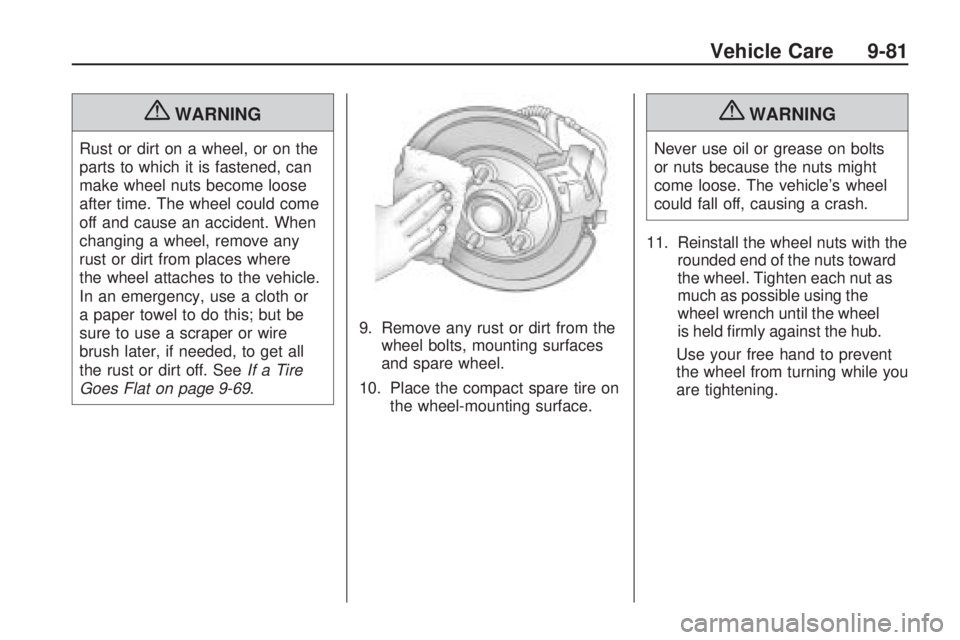
{WARNING
Rust or dirt on a wheel, or on the
parts to which it is fastened, can
make wheel nuts become loose
after time. The wheel could come
off and cause an accident. When
changing a wheel, remove any
rust or dirt from places where
the wheel attaches to the vehicle.
In an emergency, use a cloth or
a paper towel to do this; but be
sure to use a scraper or wire
brush later, if needed, to get all
the rust or dirt off. SeeIf a Tire
Goes Flat on page 9-69.9. Remove any rust or dirt from the
wheel bolts, mounting surfaces
and spare wheel.
10. Place the compact spare tire on
the wheel-mounting surface.
{WARNING
Never use oil or grease on bolts
or nuts because the nuts might
come loose. The vehicle’s wheel
could fall off, causing a crash.
11. Reinstall the wheel nuts with the
rounded end of the nuts toward
the wheel. Tighten each nut as
much as possible using the
wheel wrench until the wheel
is held firmly against the hub.
Use your free hand to prevent
the wheel from turning while you
are tightening.
Vehicle Care 9-81
Page 314 of 372
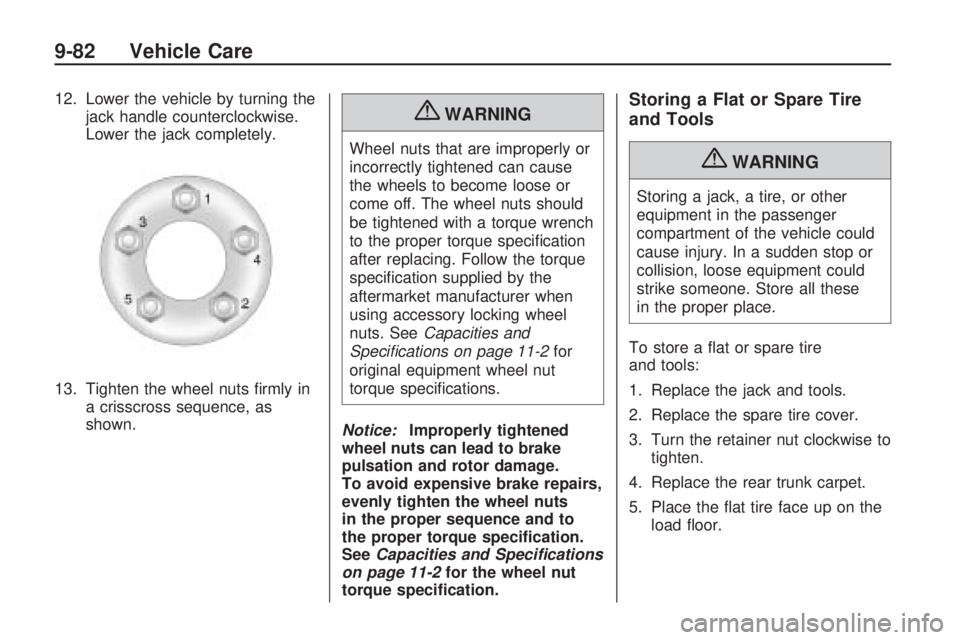
12. Lower the vehicle by turning the
jack handle counterclockwise.
Lower the jack completely.
13. Tighten the wheel nuts firmly in
a crisscross sequence, as
shown.{WARNING
Wheel nuts that are improperly or
incorrectly tightened can cause
the wheels to become loose or
come off. The wheel nuts should
be tightened with a torque wrench
to the proper torque specification
after replacing. Follow the torque
specification supplied by the
aftermarket manufacturer when
using accessory locking wheel
nuts. SeeCapacities and
Speci�cations on page 11-2for
original equipment wheel nut
torque specifications.
Notice:Improperly tightened
wheel nuts can lead to brake
pulsation and rotor damage.
To avoid expensive brake repairs,
evenly tighten the wheel nuts
in the proper sequence and to
the proper torque speci�cation.
SeeCapacities and Specifications
on page 11-2for the wheel nut
torque speci�cation.
Storing a Flat or Spare Tire
and Tools
{WARNING
Storing a jack, a tire, or other
equipment in the passenger
compartment of the vehicle could
cause injury. In a sudden stop or
collision, loose equipment could
strike someone. Store all these
in the proper place.
To store a flat or spare tire
and tools:
1. Replace the jack and tools.
2. Replace the spare tire cover.
3. Turn the retainer nut clockwise to
tighten.
4. Replace the rear trunk carpet.
5. Place the flat tire face up on the
load floor.
9-82 Vehicle Care
Page 315 of 372

6. Route the strap provided, as
shown, to secure the flat tire.
The compact spare tire is for
temporary use only. Replace the
compact spare with a full-size tire
as soon as possible.
Compact Spare Tire
{WARNING
Driving with more than one
compact spare tire at a time could
result in loss of braking and
handling. This could lead to a
crash and you or others could be
injured. Use only one compact
spare tire at a time.
If this vehicle has a compact spare
tire it was fully inflated when the
vehicle was new, however, it can
lose air after a time. Check the
inflation pressure regularly. It should
be 60 psi (420 kPa).
After installing the compact spare on
the vehicle, stop as soon as possible
and make sure the spare tire is
correctly inflated. The compact spare
is made to perform well at speeds up
to 65 mph (105 km/h) for distances
up to 3,000 miles (5 000 km), so you
can finish your trip and have thefull-size tire repaired or replaced at
your convenience. Of course, it is
best to replace the spare with a
full-size tire as soon as possible.
The spare tire will last longer and be
in good shape in case it is needed
again.
Notice:When the compact spare
is installed, do not take the vehicle
through an automatic car wash
with guide rails. The compact
spare can get caught on the rails
which can damage the tire, wheel
and other parts of the vehicle.
Do not use the compact spare on
other vehicles.
Do not mix the compact spare tire
or wheel with other wheels or tires.
They will not fit. Keep the spare tire
and its wheel together.
Notice:Tire chains will not �t
the compact spare. Using them
can damage the vehicle and can
damage the chains too. Do not use
tire chains on the compact spare.
Vehicle Care 9-83
Page 316 of 372
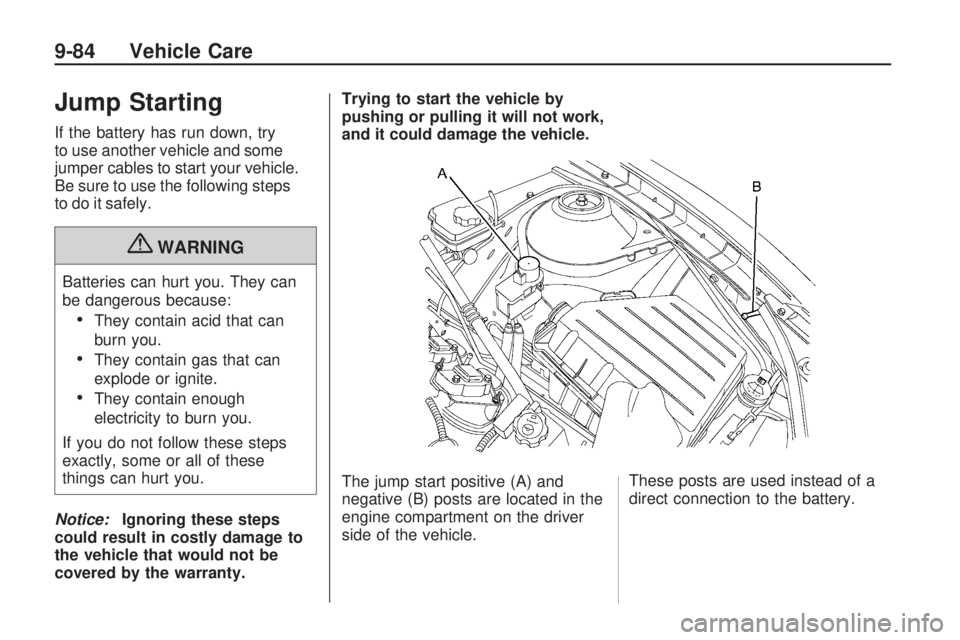
Jump Starting
If the battery has run down, try
to use another vehicle and some
jumper cables to start your vehicle.
Be sure to use the following steps
to do it safely.
{WARNING
Batteries can hurt you. They can
be dangerous because:
•They contain acid that can
burn you.
•They contain gas that can
explode or ignite.
•They contain enough
electricity to burn you.
If you do not follow these steps
exactly, some or all of these
things can hurt you.
Notice: Ignoring these steps
could result in costly damage to
the vehicle that would not be
covered by the warranty. Trying to start the vehicle by
pushing or pulling it will not work,
and it could damage the vehicle.
The jump start positive (A) and
negative (B) posts are located in the
engine compartment on the driver
side of the vehicle.
These posts are used instead of a
direct connection to the battery.
9-84 Vehicle Care
Page 317 of 372
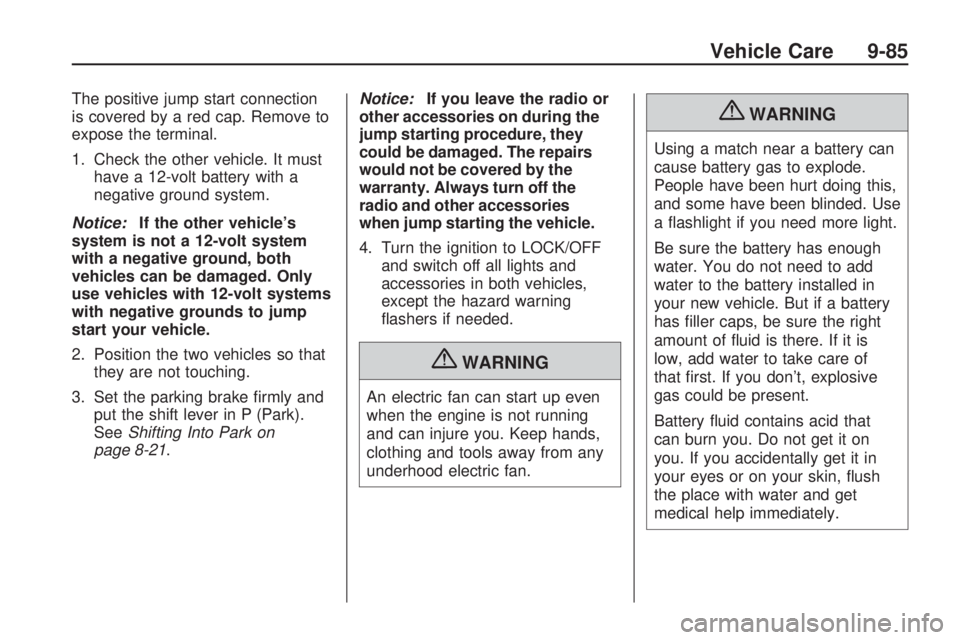
The positive jump start connection
is covered by a red cap. Remove to
expose the terminal.
1. Check the other vehicle. It must
have a 12-volt battery with a
negative ground system.
Notice:If the other vehicle’s
system is not a 12-volt system
with a negative ground, both
vehicles can be damaged. Only
use vehicles with 12-volt systems
with negative grounds to jump
start your vehicle.
2. Position the two vehicles so that
they are not touching.
3. Set the parking brake firmly and
put the shift lever in P (Park).
SeeShifting Into Park on
page 8-21.Notice:If you leave the radio or
other accessories on during the
jump starting procedure, they
could be damaged. The repairs
would not be covered by the
warranty. Always turn off the
radio and other accessories
when jump starting the vehicle.
4. Turn the ignition to LOCK/OFF
and switch off all lights and
accessories in both vehicles,
except the hazard warning
flashers if needed.
{WARNING
An electric fan can start up even
when the engine is not running
and can injure you. Keep hands,
clothing and tools away from any
underhood electric fan.
{WARNING
Using a match near a battery can
cause battery gas to explode.
People have been hurt doing this,
and some have been blinded. Use
a flashlight if you need more light.
Be sure the battery has enough
water. You do not need to add
water to the battery installed in
your new vehicle. But if a battery
has filler caps, be sure the right
amount of fluid is there. If it is
low, add water to take care of
that first. If you don’t, explosive
gas could be present.
Battery fluid contains acid that
can burn you. Do not get it on
you. If you accidentally get it in
your eyes or on your skin, flush
the place with water and get
medical help immediately.
Vehicle Care 9-85
Page 318 of 372
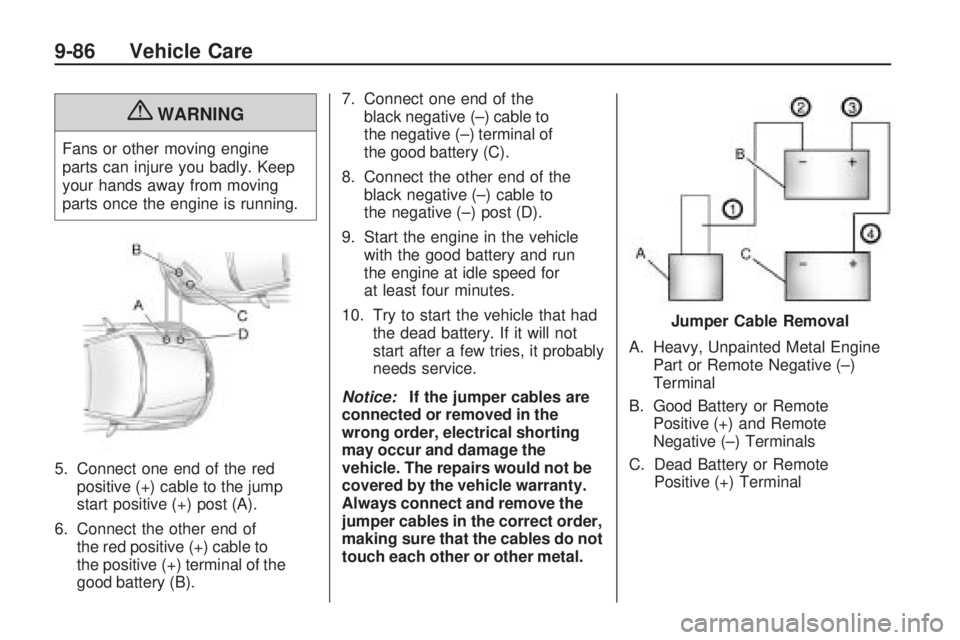
{WARNING
Fans or other moving engine
parts can injure you badly. Keep
your hands away from moving
parts once the engine is running.
5. Connect one end of the red
positive (+) cable to the jump
start positive (+) post (A).
6. Connect the other end of
the red positive (+) cable to
the positive (+) terminal of the
good battery (B).7. Connect one end of the
black negative (–) cable to
the negative (–) terminal of
the good battery (C).
8. Connect the other end of the
black negative (–) cable to
the negative (–) post (D).
9. Start the engine in the vehicle
with the good battery and run
the engine at idle speed for
at least four minutes.
10. Try to start the vehicle that had
the dead battery. If it will not
start after a few tries, it probably
needs service.
Notice:If the jumper cables are
connected or removed in the
wrong order, electrical shorting
may occur and damage the
vehicle. The repairs would not be
covered by the vehicle warranty.
Always connect and remove the
jumper cables in the correct order,
making sure that the cables do not
touch each other or other metal.A. Heavy, Unpainted Metal Engine
Part or Remote Negative (–)
Terminal
B. Good Battery or Remote
Positive (+) and Remote
Negative (–) Terminals
C. Dead Battery or Remote
Positive (+) Terminal
Jumper Cable Removal
9-86 Vehicle Care
Page 319 of 372
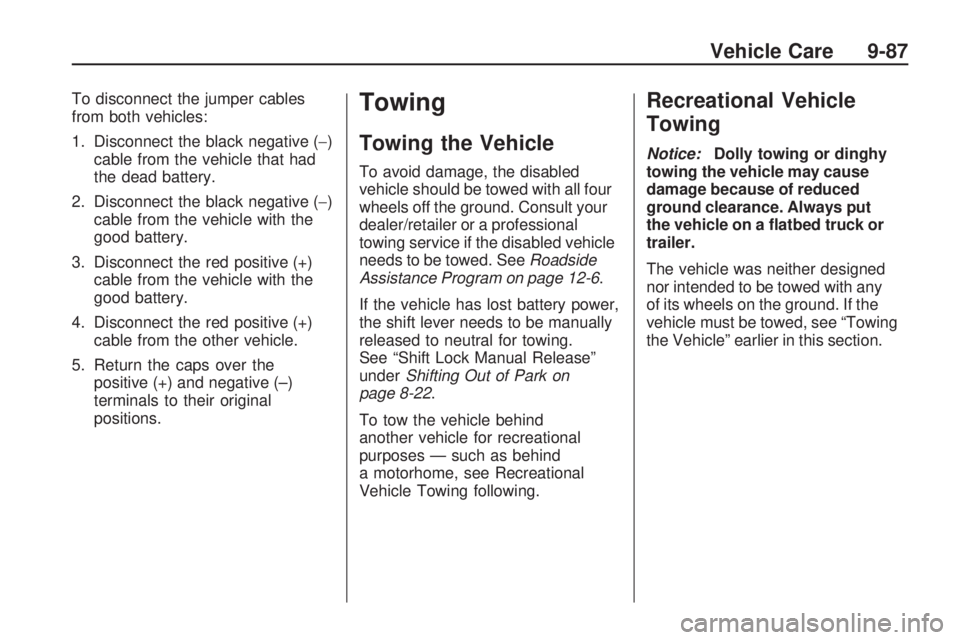
To disconnect the jumper cables
from both vehicles:
1. Disconnect the black negative (−)
cable from the vehicle that had
the dead battery.
2. Disconnect the black negative (−)
cable from the vehicle with the
good battery.
3. Disconnect the red positive (+)
cable from the vehicle with the
good battery.
4. Disconnect the red positive (+)
cable from the other vehicle.
5. Return the caps over the
positive (+) and negative (–)
terminals to their original
positions.Towing
Towing the Vehicle
To avoid damage, the disabled
vehicle should be towed with all four
wheels off the ground. Consult your
dealer/retailer or a professional
towing service if the disabled vehicle
needs to be towed. SeeRoadside
Assistance Program on page 12-6.
If the vehicle has lost battery power,
the shift lever needs to be manually
released to neutral for towing.
See “Shift Lock Manual Release”
underShifting Out of Park on
page 8-22.
To tow the vehicle behind
another vehicle for recreational
purposes — such as behind
a motorhome, see Recreational
Vehicle Towing following.
Recreational Vehicle
Towing
Notice:Dolly towing or dinghy
towing the vehicle may cause
damage because of reduced
ground clearance. Always put
the vehicle on a �atbed truck or
trailer.
The vehicle was neither designed
nor intended to be towed with any
of its wheels on the ground. If the
vehicle must be towed, see “Towing
the Vehicle” earlier in this section.
Vehicle Care 9-87
Page 320 of 372
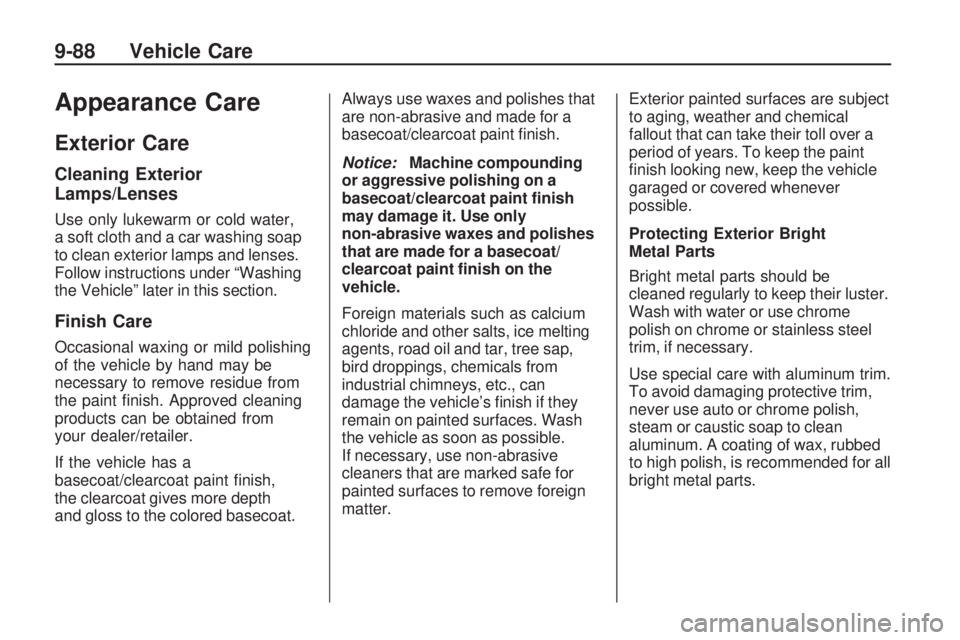
Appearance Care
Exterior Care
Cleaning Exterior
Lamps/Lenses
Use only lukewarm or cold water,
a soft cloth and a car washing soap
to clean exterior lamps and lenses.
Follow instructions under “Washing
the Vehicle” later in this section.
Finish Care
Occasional waxing or mild polishing
of the vehicle by hand may be
necessary to remove residue from
the paint finish. Approved cleaning
products can be obtained from
your dealer/retailer.
If the vehicle has a
basecoat/clearcoat paint finish,
the clearcoat gives more depth
and gloss to the colored basecoat.Always use waxes and polishes that
are non-abrasive and made for a
basecoat/clearcoat paint finish.
Notice:Machine compounding
or aggressive polishing on a
basecoat/clearcoat paint �nish
may damage it. Use only
non-abrasive waxes and polishes
that are made for a basecoat/
clearcoat paint �nish on the
vehicle.
Foreign materials such as calcium
chloride and other salts, ice melting
agents, road oil and tar, tree sap,
bird droppings, chemicals from
industrial chimneys, etc., can
damage the vehicle’s finish if they
remain on painted surfaces. Wash
the vehicle as soon as possible.
If necessary, use non-abrasive
cleaners that are marked safe for
painted surfaces to remove foreign
matter.Exterior painted surfaces are subject
to aging, weather and chemical
fallout that can take their toll over a
period of years. To keep the paint
finish looking new, keep the vehicle
garaged or covered whenever
possible.
Protecting Exterior Bright
Metal Parts
Bright metal parts should be
cleaned regularly to keep their luster.
Wash with water or use chrome
polish on chrome or stainless steel
trim, if necessary.
Use special care with aluminum trim.
To avoid damaging protective trim,
never use auto or chrome polish,
steam or caustic soap to clean
aluminum. A coating of wax, rubbed
to high polish, is recommended for all
bright metal parts.
9-88 Vehicle Care